MKT542-China Retail: Managing Conflicts to Improve Retail Networks
VerifiedAdded on 2024/01/17
|11
|3043
|256
Report
AI Summary
This report presents an article review focusing on managing conflicts within retail networks in China, particularly within the context of channel management (MKT542). It examines the applicability of a Western channel conflict management model, specifically Bradford et al.'s (2004) framework, within the Chinese business environment. The research methodology involves self-administered questionnaires distributed among channel members of Chinese electric companies, with data analyzed using multiple regression models. The review highlights the importance of cultural considerations in conflict management strategies, emphasizing that a one-size-fits-all Western model may not be universally applicable. The article offers insights into how cultural norms influence the behavior and management style of channel members, suggesting that adapting conflict management strategies to align with the target market's cultural nuances is essential for maintaining network satisfaction and continuity. The review identifies the article's strengths, such as its thorough research methodology and practical implications, while also noting limitations like a lack of originality. Ultimately, the review underscores the importance of understanding channel dynamics in diverse cultural contexts to foster effective collaboration and reduce conflict in marketing channels.
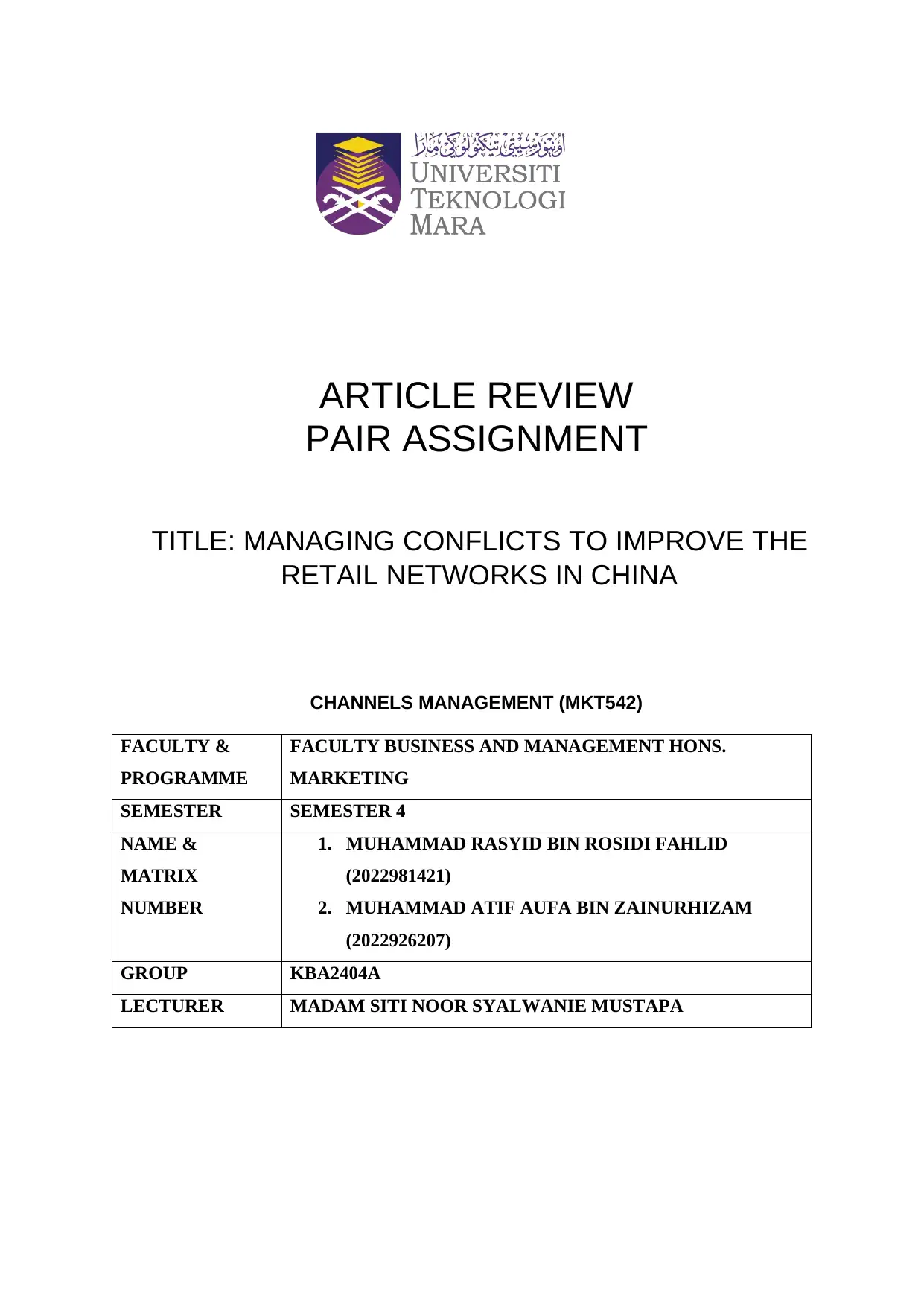
ARTICLE REVIEW
PAIR ASSIGNMENT
TITLE: MANAGING CONFLICTS TO IMPROVE THE
RETAIL NETWORKS IN CHINA
CHANNELS MANAGEMENT (MKT542)
FACULTY &
PROGRAMME
FACULTY BUSINESS AND MANAGEMENT HONS.
MARKETING
SEMESTER SEMESTER 4
NAME &
MATRIX
NUMBER
1. MUHAMMAD RASYID BIN ROSIDI FAHLID
(2022981421)
2. MUHAMMAD ATIF AUFA BIN ZAINURHIZAM
(2022926207)
GROUP KBA2404A
LECTURER MADAM SITI NOOR SYALWANIE MUSTAPA
PAIR ASSIGNMENT
TITLE: MANAGING CONFLICTS TO IMPROVE THE
RETAIL NETWORKS IN CHINA
CHANNELS MANAGEMENT (MKT542)
FACULTY &
PROGRAMME
FACULTY BUSINESS AND MANAGEMENT HONS.
MARKETING
SEMESTER SEMESTER 4
NAME &
MATRIX
NUMBER
1. MUHAMMAD RASYID BIN ROSIDI FAHLID
(2022981421)
2. MUHAMMAD ATIF AUFA BIN ZAINURHIZAM
(2022926207)
GROUP KBA2404A
LECTURER MADAM SITI NOOR SYALWANIE MUSTAPA
Paraphrase This Document
Need a fresh take? Get an instant paraphrase of this document with our AI Paraphraser

2
Contents
1.0 INTRODUCTION ............................................................................................................ 3
2.0 FINDING AND DISCUSSION ....................................................................................... 5
3.0 CONCLUSION .............................................................................................................. 10
References ................................................................................................................................ 11
Contents
1.0 INTRODUCTION ............................................................................................................ 3
2.0 FINDING AND DISCUSSION ....................................................................................... 5
3.0 CONCLUSION .............................................................................................................. 10
References ................................................................................................................................ 11
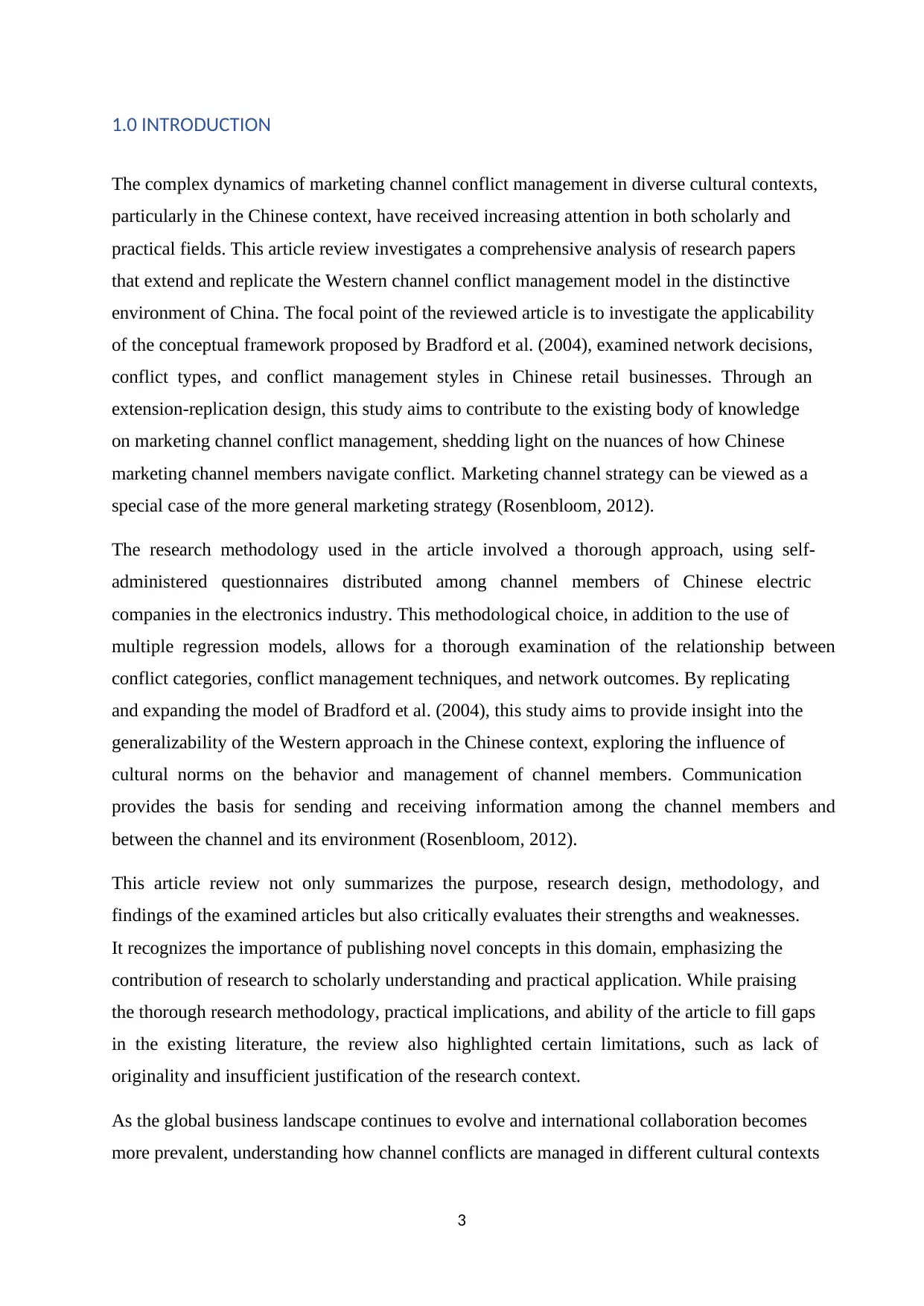
3
1.0 INTRODUCTION
The complex dynamics of marketing channel conflict management in diverse cultural contexts,
particularly in the Chinese context, have received increasing attention in both scholarly and
practical fields. This article review investigates a comprehensive analysis of research papers
that extend and replicate the Western channel conflict management model in the distinctive
environment of China. The focal point of the reviewed article is to investigate the applicability
of the conceptual framework proposed by Bradford et al. (2004), examined network decisions,
conflict types, and conflict management styles in Chinese retail businesses. Through an
extension-replication design, this study aims to contribute to the existing body of knowledge
on marketing channel conflict management, shedding light on the nuances of how Chinese
marketing channel members navigate conflict. Marketing channel strategy can be viewed as a
special case of the more general marketing strategy (Rosenbloom, 2012).
The research methodology used in the article involved a thorough approach, using self-
administered questionnaires distributed among channel members of Chinese electric
companies in the electronics industry. This methodological choice, in addition to the use of
multiple regression models, allows for a thorough examination of the relationship between
conflict categories, conflict management techniques, and network outcomes. By replicating
and expanding the model of Bradford et al. (2004), this study aims to provide insight into the
generalizability of the Western approach in the Chinese context, exploring the influence of
cultural norms on the behavior and management of channel members. Communication
provides the basis for sending and receiving information among the channel members and
between the channel and its environment (Rosenbloom, 2012).
This article review not only summarizes the purpose, research design, methodology, and
findings of the examined articles but also critically evaluates their strengths and weaknesses.
It recognizes the importance of publishing novel concepts in this domain, emphasizing the
contribution of research to scholarly understanding and practical application. While praising
the thorough research methodology, practical implications, and ability of the article to fill gaps
in the existing literature, the review also highlighted certain limitations, such as lack of
originality and insufficient justification of the research context.
As the global business landscape continues to evolve and international collaboration becomes
more prevalent, understanding how channel conflicts are managed in different cultural contexts
1.0 INTRODUCTION
The complex dynamics of marketing channel conflict management in diverse cultural contexts,
particularly in the Chinese context, have received increasing attention in both scholarly and
practical fields. This article review investigates a comprehensive analysis of research papers
that extend and replicate the Western channel conflict management model in the distinctive
environment of China. The focal point of the reviewed article is to investigate the applicability
of the conceptual framework proposed by Bradford et al. (2004), examined network decisions,
conflict types, and conflict management styles in Chinese retail businesses. Through an
extension-replication design, this study aims to contribute to the existing body of knowledge
on marketing channel conflict management, shedding light on the nuances of how Chinese
marketing channel members navigate conflict. Marketing channel strategy can be viewed as a
special case of the more general marketing strategy (Rosenbloom, 2012).
The research methodology used in the article involved a thorough approach, using self-
administered questionnaires distributed among channel members of Chinese electric
companies in the electronics industry. This methodological choice, in addition to the use of
multiple regression models, allows for a thorough examination of the relationship between
conflict categories, conflict management techniques, and network outcomes. By replicating
and expanding the model of Bradford et al. (2004), this study aims to provide insight into the
generalizability of the Western approach in the Chinese context, exploring the influence of
cultural norms on the behavior and management of channel members. Communication
provides the basis for sending and receiving information among the channel members and
between the channel and its environment (Rosenbloom, 2012).
This article review not only summarizes the purpose, research design, methodology, and
findings of the examined articles but also critically evaluates their strengths and weaknesses.
It recognizes the importance of publishing novel concepts in this domain, emphasizing the
contribution of research to scholarly understanding and practical application. While praising
the thorough research methodology, practical implications, and ability of the article to fill gaps
in the existing literature, the review also highlighted certain limitations, such as lack of
originality and insufficient justification of the research context.
As the global business landscape continues to evolve and international collaboration becomes
more prevalent, understanding how channel conflicts are managed in different cultural contexts
⊘ This is a preview!⊘
Do you want full access?
Subscribe today to unlock all pages.

Trusted by 1+ million students worldwide
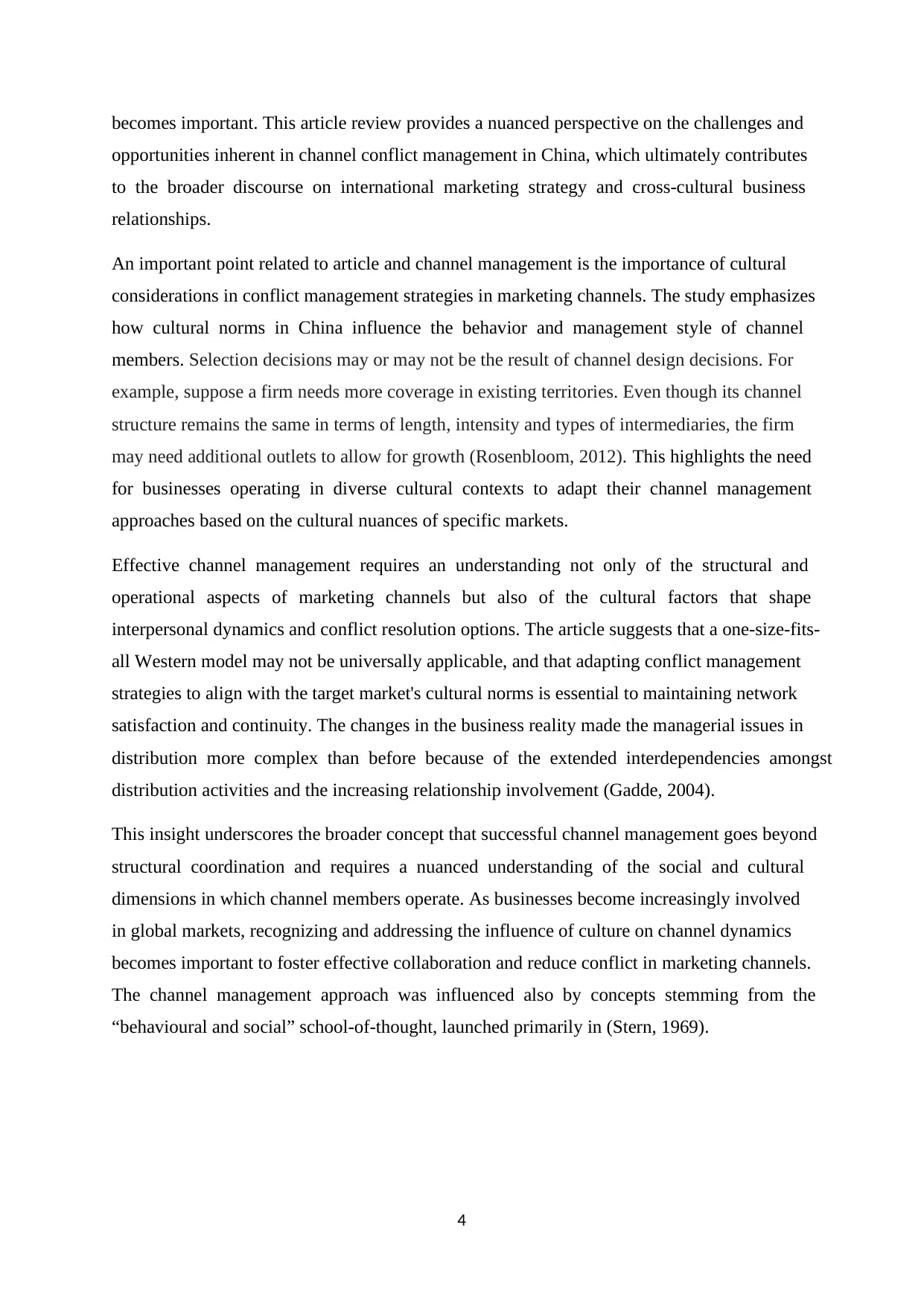
4
becomes important. This article review provides a nuanced perspective on the challenges and
opportunities inherent in channel conflict management in China, which ultimately contributes
to the broader discourse on international marketing strategy and cross-cultural business
relationships.
An important point related to article and channel management is the importance of cultural
considerations in conflict management strategies in marketing channels. The study emphasizes
how cultural norms in China influence the behavior and management style of channel
members. Selection decisions may or may not be the result of channel design decisions. For
example, suppose a firm needs more coverage in existing territories. Even though its channel
structure remains the same in terms of length, intensity and types of intermediaries, the firm
may need additional outlets to allow for growth (Rosenbloom, 2012). This highlights the need
for businesses operating in diverse cultural contexts to adapt their channel management
approaches based on the cultural nuances of specific markets.
Effective channel management requires an understanding not only of the structural and
operational aspects of marketing channels but also of the cultural factors that shape
interpersonal dynamics and conflict resolution options. The article suggests that a one-size-fits-
all Western model may not be universally applicable, and that adapting conflict management
strategies to align with the target market's cultural norms is essential to maintaining network
satisfaction and continuity. The changes in the business reality made the managerial issues in
distribution more complex than before because of the extended interdependencies amongst
distribution activities and the increasing relationship involvement (Gadde, 2004).
This insight underscores the broader concept that successful channel management goes beyond
structural coordination and requires a nuanced understanding of the social and cultural
dimensions in which channel members operate. As businesses become increasingly involved
in global markets, recognizing and addressing the influence of culture on channel dynamics
becomes important to foster effective collaboration and reduce conflict in marketing channels.
The channel management approach was influenced also by concepts stemming from the
“behavioural and social” school-of-thought, launched primarily in (Stern, 1969).
becomes important. This article review provides a nuanced perspective on the challenges and
opportunities inherent in channel conflict management in China, which ultimately contributes
to the broader discourse on international marketing strategy and cross-cultural business
relationships.
An important point related to article and channel management is the importance of cultural
considerations in conflict management strategies in marketing channels. The study emphasizes
how cultural norms in China influence the behavior and management style of channel
members. Selection decisions may or may not be the result of channel design decisions. For
example, suppose a firm needs more coverage in existing territories. Even though its channel
structure remains the same in terms of length, intensity and types of intermediaries, the firm
may need additional outlets to allow for growth (Rosenbloom, 2012). This highlights the need
for businesses operating in diverse cultural contexts to adapt their channel management
approaches based on the cultural nuances of specific markets.
Effective channel management requires an understanding not only of the structural and
operational aspects of marketing channels but also of the cultural factors that shape
interpersonal dynamics and conflict resolution options. The article suggests that a one-size-fits-
all Western model may not be universally applicable, and that adapting conflict management
strategies to align with the target market's cultural norms is essential to maintaining network
satisfaction and continuity. The changes in the business reality made the managerial issues in
distribution more complex than before because of the extended interdependencies amongst
distribution activities and the increasing relationship involvement (Gadde, 2004).
This insight underscores the broader concept that successful channel management goes beyond
structural coordination and requires a nuanced understanding of the social and cultural
dimensions in which channel members operate. As businesses become increasingly involved
in global markets, recognizing and addressing the influence of culture on channel dynamics
becomes important to foster effective collaboration and reduce conflict in marketing channels.
The channel management approach was influenced also by concepts stemming from the
“behavioural and social” school-of-thought, launched primarily in (Stern, 1969).
Paraphrase This Document
Need a fresh take? Get an instant paraphrase of this document with our AI Paraphraser
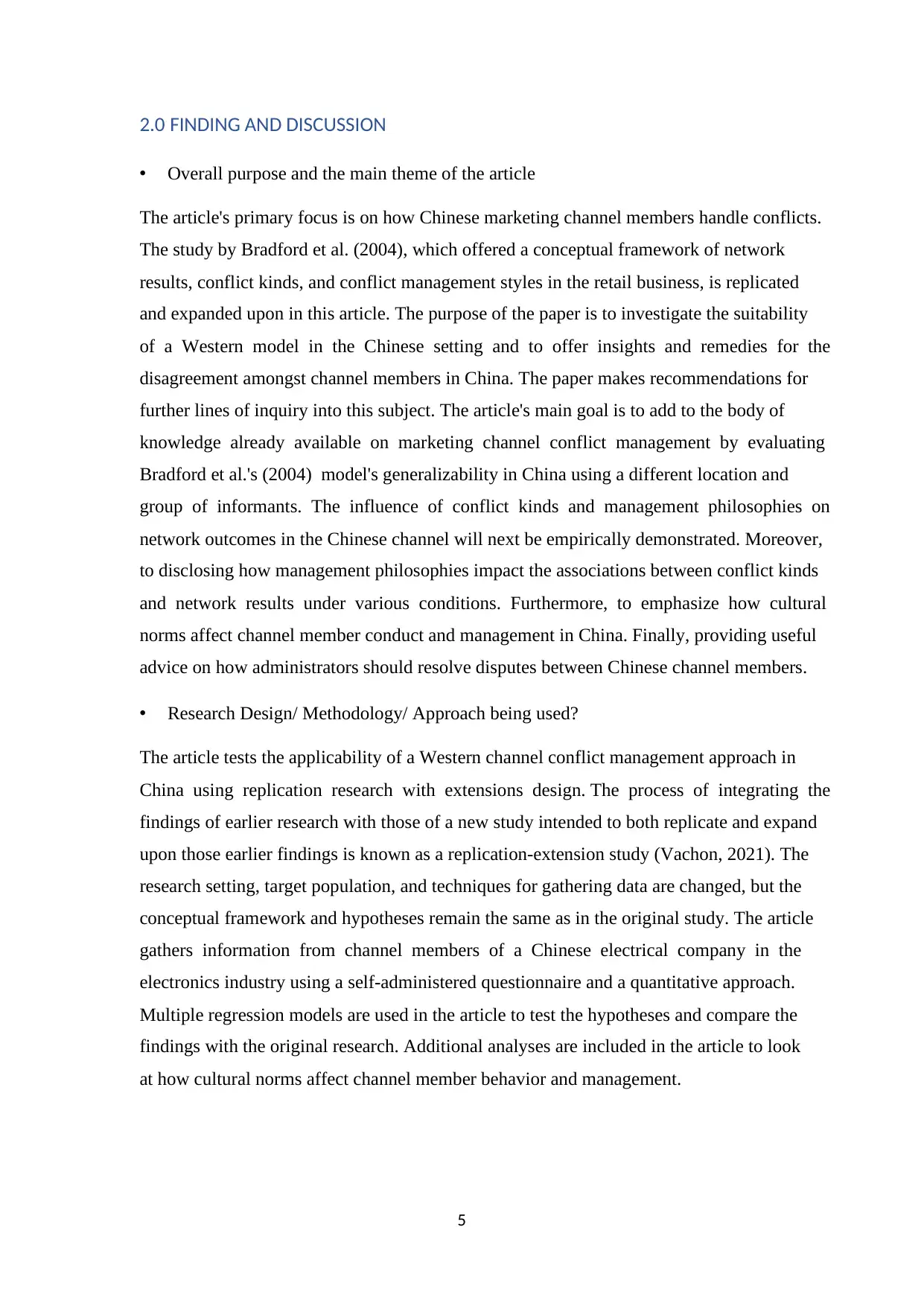
5
2.0 FINDING AND DISCUSSION
• Overall purpose and the main theme of the article
The article's primary focus is on how Chinese marketing channel members handle conflicts.
The study by Bradford et al. (2004), which offered a conceptual framework of network
results, conflict kinds, and conflict management styles in the retail business, is replicated
and expanded upon in this article. The purpose of the paper is to investigate the suitability
of a Western model in the Chinese setting and to offer insights and remedies for the
disagreement amongst channel members in China. The paper makes recommendations for
further lines of inquiry into this subject. The article's main goal is to add to the body of
knowledge already available on marketing channel conflict management by evaluating
Bradford et al.'s (2004) model's generalizability in China using a different location and
group of informants. The influence of conflict kinds and management philosophies on
network outcomes in the Chinese channel will next be empirically demonstrated. Moreover,
to disclosing how management philosophies impact the associations between conflict kinds
and network results under various conditions. Furthermore, to emphasize how cultural
norms affect channel member conduct and management in China. Finally, providing useful
advice on how administrators should resolve disputes between Chinese channel members.
• Research Design/ Methodology/ Approach being used?
The article tests the applicability of a Western channel conflict management approach in
China using replication research with extensions design. The process of integrating the
findings of earlier research with those of a new study intended to both replicate and expand
upon those earlier findings is known as a replication-extension study (Vachon, 2021). The
research setting, target population, and techniques for gathering data are changed, but the
conceptual framework and hypotheses remain the same as in the original study. The article
gathers information from channel members of a Chinese electrical company in the
electronics industry using a self-administered questionnaire and a quantitative approach.
Multiple regression models are used in the article to test the hypotheses and compare the
findings with the original research. Additional analyses are included in the article to look
at how cultural norms affect channel member behavior and management.
2.0 FINDING AND DISCUSSION
• Overall purpose and the main theme of the article
The article's primary focus is on how Chinese marketing channel members handle conflicts.
The study by Bradford et al. (2004), which offered a conceptual framework of network
results, conflict kinds, and conflict management styles in the retail business, is replicated
and expanded upon in this article. The purpose of the paper is to investigate the suitability
of a Western model in the Chinese setting and to offer insights and remedies for the
disagreement amongst channel members in China. The paper makes recommendations for
further lines of inquiry into this subject. The article's main goal is to add to the body of
knowledge already available on marketing channel conflict management by evaluating
Bradford et al.'s (2004) model's generalizability in China using a different location and
group of informants. The influence of conflict kinds and management philosophies on
network outcomes in the Chinese channel will next be empirically demonstrated. Moreover,
to disclosing how management philosophies impact the associations between conflict kinds
and network results under various conditions. Furthermore, to emphasize how cultural
norms affect channel member conduct and management in China. Finally, providing useful
advice on how administrators should resolve disputes between Chinese channel members.
• Research Design/ Methodology/ Approach being used?
The article tests the applicability of a Western channel conflict management approach in
China using replication research with extensions design. The process of integrating the
findings of earlier research with those of a new study intended to both replicate and expand
upon those earlier findings is known as a replication-extension study (Vachon, 2021). The
research setting, target population, and techniques for gathering data are changed, but the
conceptual framework and hypotheses remain the same as in the original study. The article
gathers information from channel members of a Chinese electrical company in the
electronics industry using a self-administered questionnaire and a quantitative approach.
Multiple regression models are used in the article to test the hypotheses and compare the
findings with the original research. Additional analyses are included in the article to look
at how cultural norms affect channel member behavior and management.
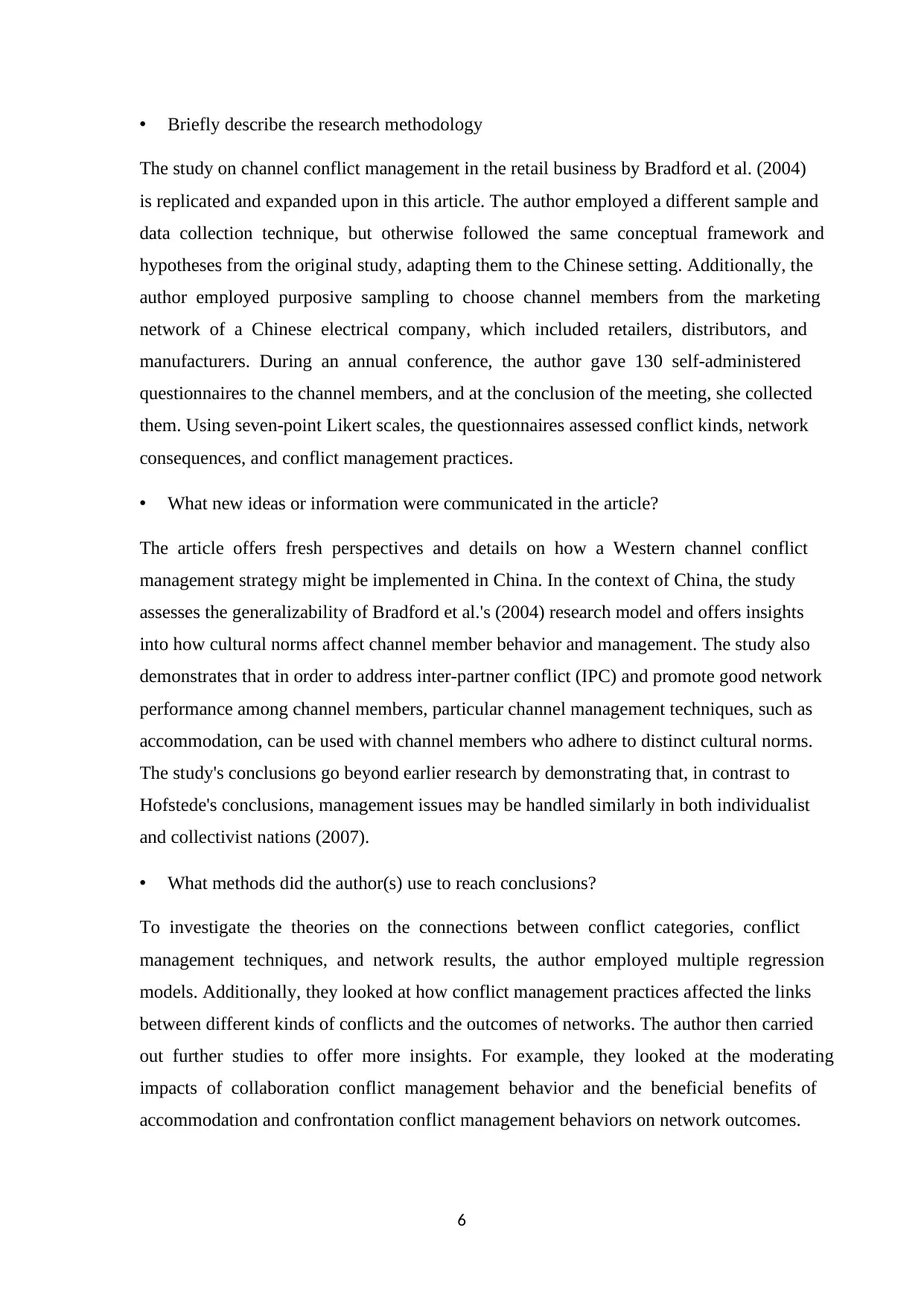
6
• Briefly describe the research methodology
The study on channel conflict management in the retail business by Bradford et al. (2004)
is replicated and expanded upon in this article. The author employed a different sample and
data collection technique, but otherwise followed the same conceptual framework and
hypotheses from the original study, adapting them to the Chinese setting. Additionally, the
author employed purposive sampling to choose channel members from the marketing
network of a Chinese electrical company, which included retailers, distributors, and
manufacturers. During an annual conference, the author gave 130 self-administered
questionnaires to the channel members, and at the conclusion of the meeting, she collected
them. Using seven-point Likert scales, the questionnaires assessed conflict kinds, network
consequences, and conflict management practices.
• What new ideas or information were communicated in the article?
The article offers fresh perspectives and details on how a Western channel conflict
management strategy might be implemented in China. In the context of China, the study
assesses the generalizability of Bradford et al.'s (2004) research model and offers insights
into how cultural norms affect channel member behavior and management. The study also
demonstrates that in order to address inter-partner conflict (IPC) and promote good network
performance among channel members, particular channel management techniques, such as
accommodation, can be used with channel members who adhere to distinct cultural norms.
The study's conclusions go beyond earlier research by demonstrating that, in contrast to
Hofstede's conclusions, management issues may be handled similarly in both individualist
and collectivist nations (2007).
• What methods did the author(s) use to reach conclusions?
To investigate the theories on the connections between conflict categories, conflict
management techniques, and network results, the author employed multiple regression
models. Additionally, they looked at how conflict management practices affected the links
between different kinds of conflicts and the outcomes of networks. The author then carried
out further studies to offer more insights. For example, they looked at the moderating
impacts of collaboration conflict management behavior and the beneficial benefits of
accommodation and confrontation conflict management behaviors on network outcomes.
• Briefly describe the research methodology
The study on channel conflict management in the retail business by Bradford et al. (2004)
is replicated and expanded upon in this article. The author employed a different sample and
data collection technique, but otherwise followed the same conceptual framework and
hypotheses from the original study, adapting them to the Chinese setting. Additionally, the
author employed purposive sampling to choose channel members from the marketing
network of a Chinese electrical company, which included retailers, distributors, and
manufacturers. During an annual conference, the author gave 130 self-administered
questionnaires to the channel members, and at the conclusion of the meeting, she collected
them. Using seven-point Likert scales, the questionnaires assessed conflict kinds, network
consequences, and conflict management practices.
• What new ideas or information were communicated in the article?
The article offers fresh perspectives and details on how a Western channel conflict
management strategy might be implemented in China. In the context of China, the study
assesses the generalizability of Bradford et al.'s (2004) research model and offers insights
into how cultural norms affect channel member behavior and management. The study also
demonstrates that in order to address inter-partner conflict (IPC) and promote good network
performance among channel members, particular channel management techniques, such as
accommodation, can be used with channel members who adhere to distinct cultural norms.
The study's conclusions go beyond earlier research by demonstrating that, in contrast to
Hofstede's conclusions, management issues may be handled similarly in both individualist
and collectivist nations (2007).
• What methods did the author(s) use to reach conclusions?
To investigate the theories on the connections between conflict categories, conflict
management techniques, and network results, the author employed multiple regression
models. Additionally, they looked at how conflict management practices affected the links
between different kinds of conflicts and the outcomes of networks. The author then carried
out further studies to offer more insights. For example, they looked at the moderating
impacts of collaboration conflict management behavior and the beneficial benefits of
accommodation and confrontation conflict management behaviors on network outcomes.
⊘ This is a preview!⊘
Do you want full access?
Subscribe today to unlock all pages.

Trusted by 1+ million students worldwide
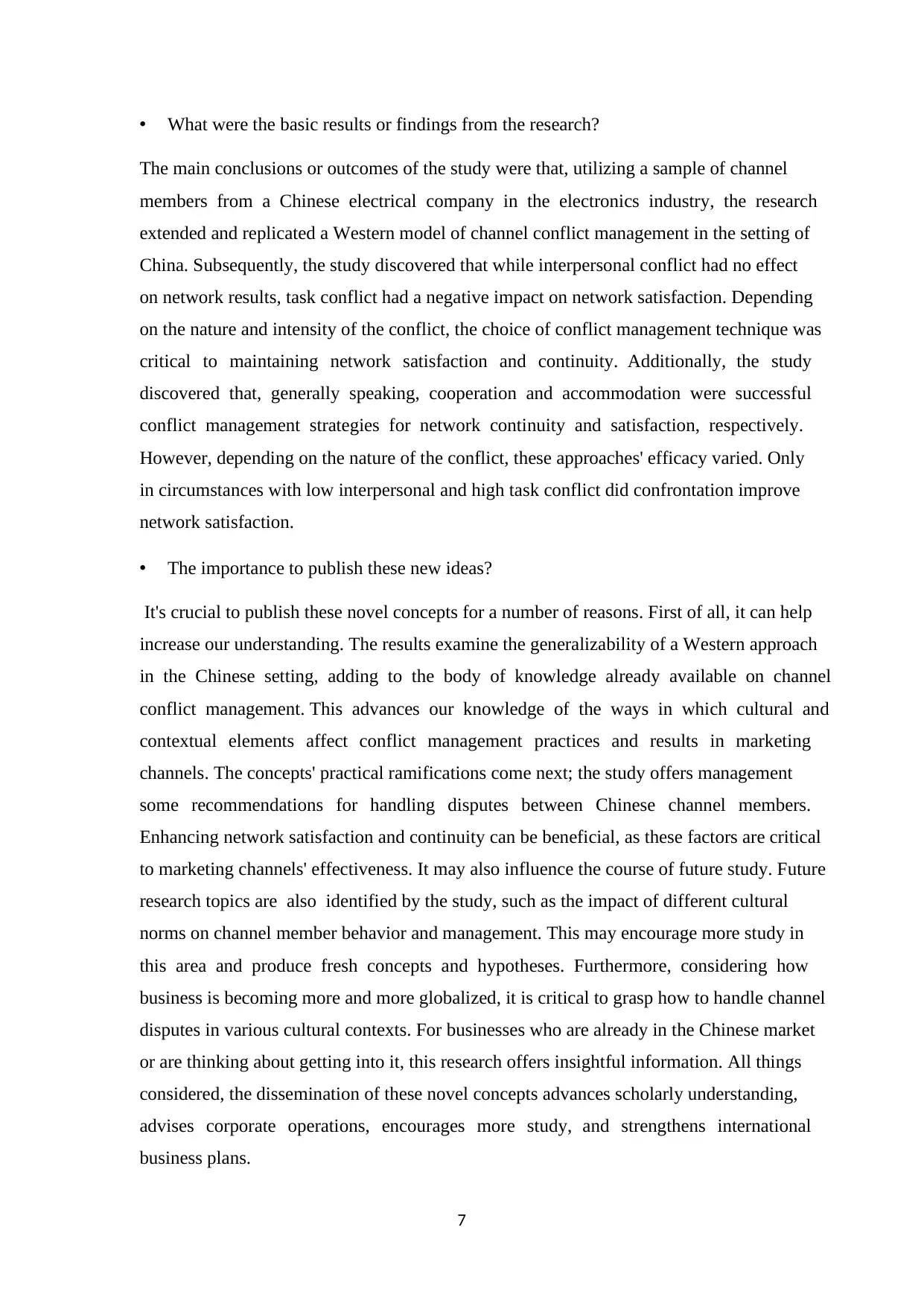
7
• What were the basic results or findings from the research?
The main conclusions or outcomes of the study were that, utilizing a sample of channel
members from a Chinese electrical company in the electronics industry, the research
extended and replicated a Western model of channel conflict management in the setting of
China. Subsequently, the study discovered that while interpersonal conflict had no effect
on network results, task conflict had a negative impact on network satisfaction. Depending
on the nature and intensity of the conflict, the choice of conflict management technique was
critical to maintaining network satisfaction and continuity. Additionally, the study
discovered that, generally speaking, cooperation and accommodation were successful
conflict management strategies for network continuity and satisfaction, respectively.
However, depending on the nature of the conflict, these approaches' efficacy varied. Only
in circumstances with low interpersonal and high task conflict did confrontation improve
network satisfaction.
• The importance to publish these new ideas?
It's crucial to publish these novel concepts for a number of reasons. First of all, it can help
increase our understanding. The results examine the generalizability of a Western approach
in the Chinese setting, adding to the body of knowledge already available on channel
conflict management. This advances our knowledge of the ways in which cultural and
contextual elements affect conflict management practices and results in marketing
channels. The concepts' practical ramifications come next; the study offers management
some recommendations for handling disputes between Chinese channel members.
Enhancing network satisfaction and continuity can be beneficial, as these factors are critical
to marketing channels' effectiveness. It may also influence the course of future study. Future
research topics are also identified by the study, such as the impact of different cultural
norms on channel member behavior and management. This may encourage more study in
this area and produce fresh concepts and hypotheses. Furthermore, considering how
business is becoming more and more globalized, it is critical to grasp how to handle channel
disputes in various cultural contexts. For businesses who are already in the Chinese market
or are thinking about getting into it, this research offers insightful information. All things
considered, the dissemination of these novel concepts advances scholarly understanding,
advises corporate operations, encourages more study, and strengthens international
business plans.
• What were the basic results or findings from the research?
The main conclusions or outcomes of the study were that, utilizing a sample of channel
members from a Chinese electrical company in the electronics industry, the research
extended and replicated a Western model of channel conflict management in the setting of
China. Subsequently, the study discovered that while interpersonal conflict had no effect
on network results, task conflict had a negative impact on network satisfaction. Depending
on the nature and intensity of the conflict, the choice of conflict management technique was
critical to maintaining network satisfaction and continuity. Additionally, the study
discovered that, generally speaking, cooperation and accommodation were successful
conflict management strategies for network continuity and satisfaction, respectively.
However, depending on the nature of the conflict, these approaches' efficacy varied. Only
in circumstances with low interpersonal and high task conflict did confrontation improve
network satisfaction.
• The importance to publish these new ideas?
It's crucial to publish these novel concepts for a number of reasons. First of all, it can help
increase our understanding. The results examine the generalizability of a Western approach
in the Chinese setting, adding to the body of knowledge already available on channel
conflict management. This advances our knowledge of the ways in which cultural and
contextual elements affect conflict management practices and results in marketing
channels. The concepts' practical ramifications come next; the study offers management
some recommendations for handling disputes between Chinese channel members.
Enhancing network satisfaction and continuity can be beneficial, as these factors are critical
to marketing channels' effectiveness. It may also influence the course of future study. Future
research topics are also identified by the study, such as the impact of different cultural
norms on channel member behavior and management. This may encourage more study in
this area and produce fresh concepts and hypotheses. Furthermore, considering how
business is becoming more and more globalized, it is critical to grasp how to handle channel
disputes in various cultural contexts. For businesses who are already in the Chinese market
or are thinking about getting into it, this research offers insightful information. All things
considered, the dissemination of these novel concepts advances scholarly understanding,
advises corporate operations, encourages more study, and strengthens international
business plans.
Paraphrase This Document
Need a fresh take? Get an instant paraphrase of this document with our AI Paraphraser
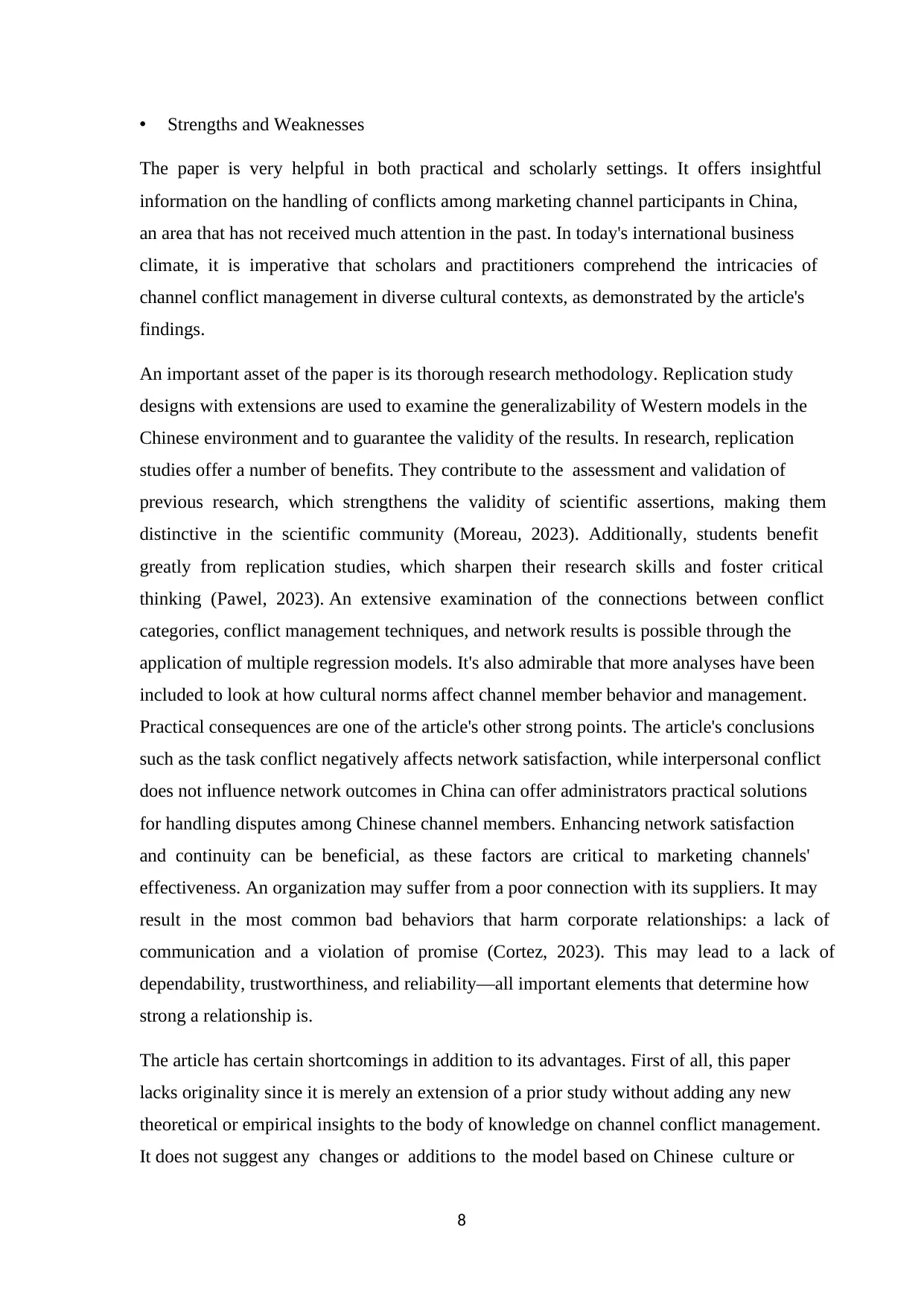
8
• Strengths and Weaknesses
The paper is very helpful in both practical and scholarly settings. It offers insightful
information on the handling of conflicts among marketing channel participants in China,
an area that has not received much attention in the past. In today's international business
climate, it is imperative that scholars and practitioners comprehend the intricacies of
channel conflict management in diverse cultural contexts, as demonstrated by the article's
findings.
An important asset of the paper is its thorough research methodology. Replication study
designs with extensions are used to examine the generalizability of Western models in the
Chinese environment and to guarantee the validity of the results. In research, replication
studies offer a number of benefits. They contribute to the assessment and validation of
previous research, which strengthens the validity of scientific assertions, making them
distinctive in the scientific community (Moreau, 2023). Additionally, students benefit
greatly from replication studies, which sharpen their research skills and foster critical
thinking (Pawel, 2023). An extensive examination of the connections between conflict
categories, conflict management techniques, and network results is possible through the
application of multiple regression models. It's also admirable that more analyses have been
included to look at how cultural norms affect channel member behavior and management.
Practical consequences are one of the article's other strong points. The article's conclusions
such as the task conflict negatively affects network satisfaction, while interpersonal conflict
does not influence network outcomes in China can offer administrators practical solutions
for handling disputes among Chinese channel members. Enhancing network satisfaction
and continuity can be beneficial, as these factors are critical to marketing channels'
effectiveness. An organization may suffer from a poor connection with its suppliers. It may
result in the most common bad behaviors that harm corporate relationships: a lack of
communication and a violation of promise (Cortez, 2023). This may lead to a lack of
dependability, trustworthiness, and reliability—all important elements that determine how
strong a relationship is.
The article has certain shortcomings in addition to its advantages. First of all, this paper
lacks originality since it is merely an extension of a prior study without adding any new
theoretical or empirical insights to the body of knowledge on channel conflict management.
It does not suggest any changes or additions to the model based on Chinese culture or
• Strengths and Weaknesses
The paper is very helpful in both practical and scholarly settings. It offers insightful
information on the handling of conflicts among marketing channel participants in China,
an area that has not received much attention in the past. In today's international business
climate, it is imperative that scholars and practitioners comprehend the intricacies of
channel conflict management in diverse cultural contexts, as demonstrated by the article's
findings.
An important asset of the paper is its thorough research methodology. Replication study
designs with extensions are used to examine the generalizability of Western models in the
Chinese environment and to guarantee the validity of the results. In research, replication
studies offer a number of benefits. They contribute to the assessment and validation of
previous research, which strengthens the validity of scientific assertions, making them
distinctive in the scientific community (Moreau, 2023). Additionally, students benefit
greatly from replication studies, which sharpen their research skills and foster critical
thinking (Pawel, 2023). An extensive examination of the connections between conflict
categories, conflict management techniques, and network results is possible through the
application of multiple regression models. It's also admirable that more analyses have been
included to look at how cultural norms affect channel member behavior and management.
Practical consequences are one of the article's other strong points. The article's conclusions
such as the task conflict negatively affects network satisfaction, while interpersonal conflict
does not influence network outcomes in China can offer administrators practical solutions
for handling disputes among Chinese channel members. Enhancing network satisfaction
and continuity can be beneficial, as these factors are critical to marketing channels'
effectiveness. An organization may suffer from a poor connection with its suppliers. It may
result in the most common bad behaviors that harm corporate relationships: a lack of
communication and a violation of promise (Cortez, 2023). This may lead to a lack of
dependability, trustworthiness, and reliability—all important elements that determine how
strong a relationship is.
The article has certain shortcomings in addition to its advantages. First of all, this paper
lacks originality since it is merely an extension of a prior study without adding any new
theoretical or empirical insights to the body of knowledge on channel conflict management.
It does not suggest any changes or additions to the model based on Chinese culture or
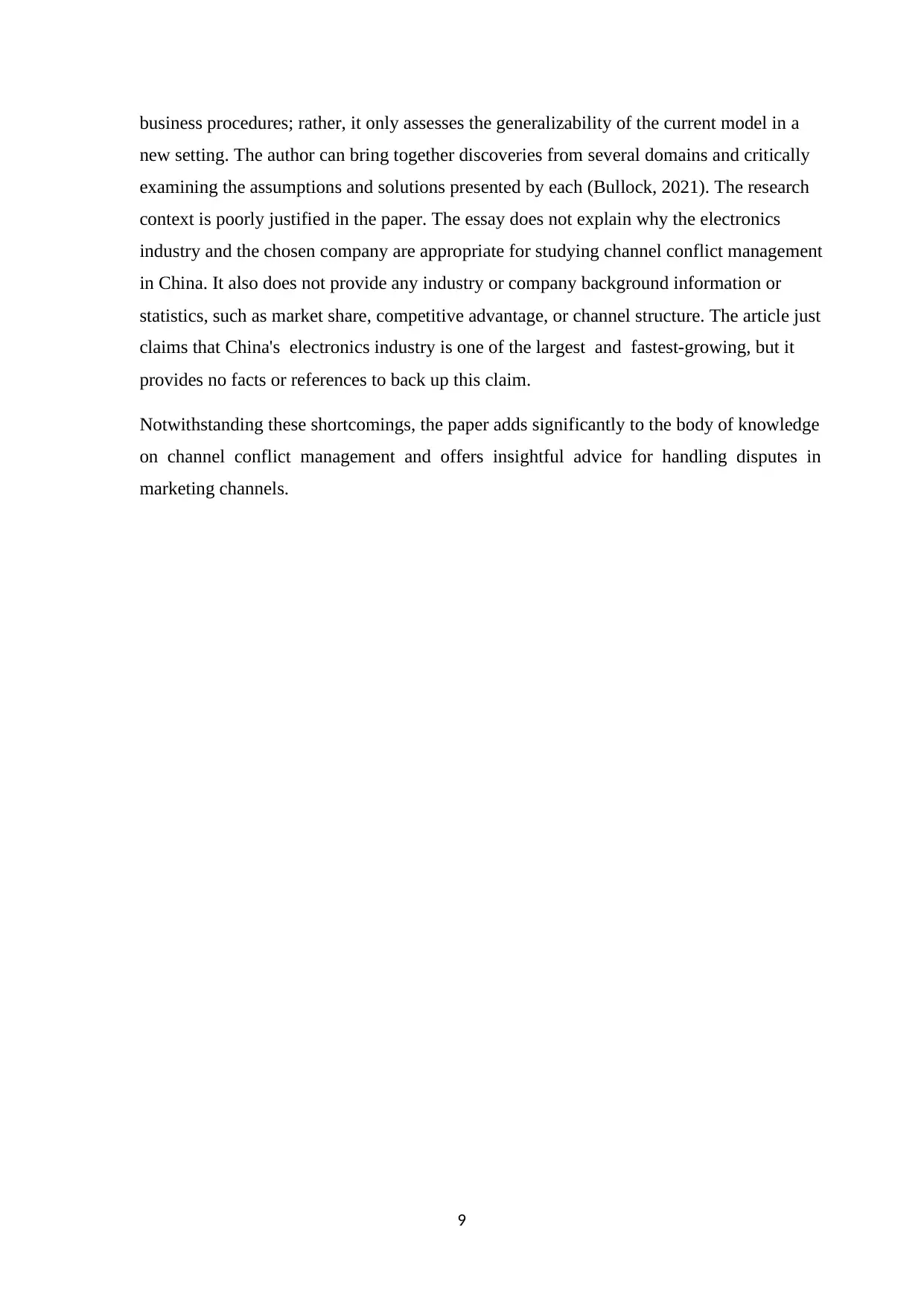
9
business procedures; rather, it only assesses the generalizability of the current model in a
new setting. The author can bring together discoveries from several domains and critically
examining the assumptions and solutions presented by each (Bullock, 2021). The research
context is poorly justified in the paper. The essay does not explain why the electronics
industry and the chosen company are appropriate for studying channel conflict management
in China. It also does not provide any industry or company background information or
statistics, such as market share, competitive advantage, or channel structure. The article just
claims that China's electronics industry is one of the largest and fastest-growing, but it
provides no facts or references to back up this claim.
Notwithstanding these shortcomings, the paper adds significantly to the body of knowledge
on channel conflict management and offers insightful advice for handling disputes in
marketing channels.
business procedures; rather, it only assesses the generalizability of the current model in a
new setting. The author can bring together discoveries from several domains and critically
examining the assumptions and solutions presented by each (Bullock, 2021). The research
context is poorly justified in the paper. The essay does not explain why the electronics
industry and the chosen company are appropriate for studying channel conflict management
in China. It also does not provide any industry or company background information or
statistics, such as market share, competitive advantage, or channel structure. The article just
claims that China's electronics industry is one of the largest and fastest-growing, but it
provides no facts or references to back up this claim.
Notwithstanding these shortcomings, the paper adds significantly to the body of knowledge
on channel conflict management and offers insightful advice for handling disputes in
marketing channels.
⊘ This is a preview!⊘
Do you want full access?
Subscribe today to unlock all pages.

Trusted by 1+ million students worldwide
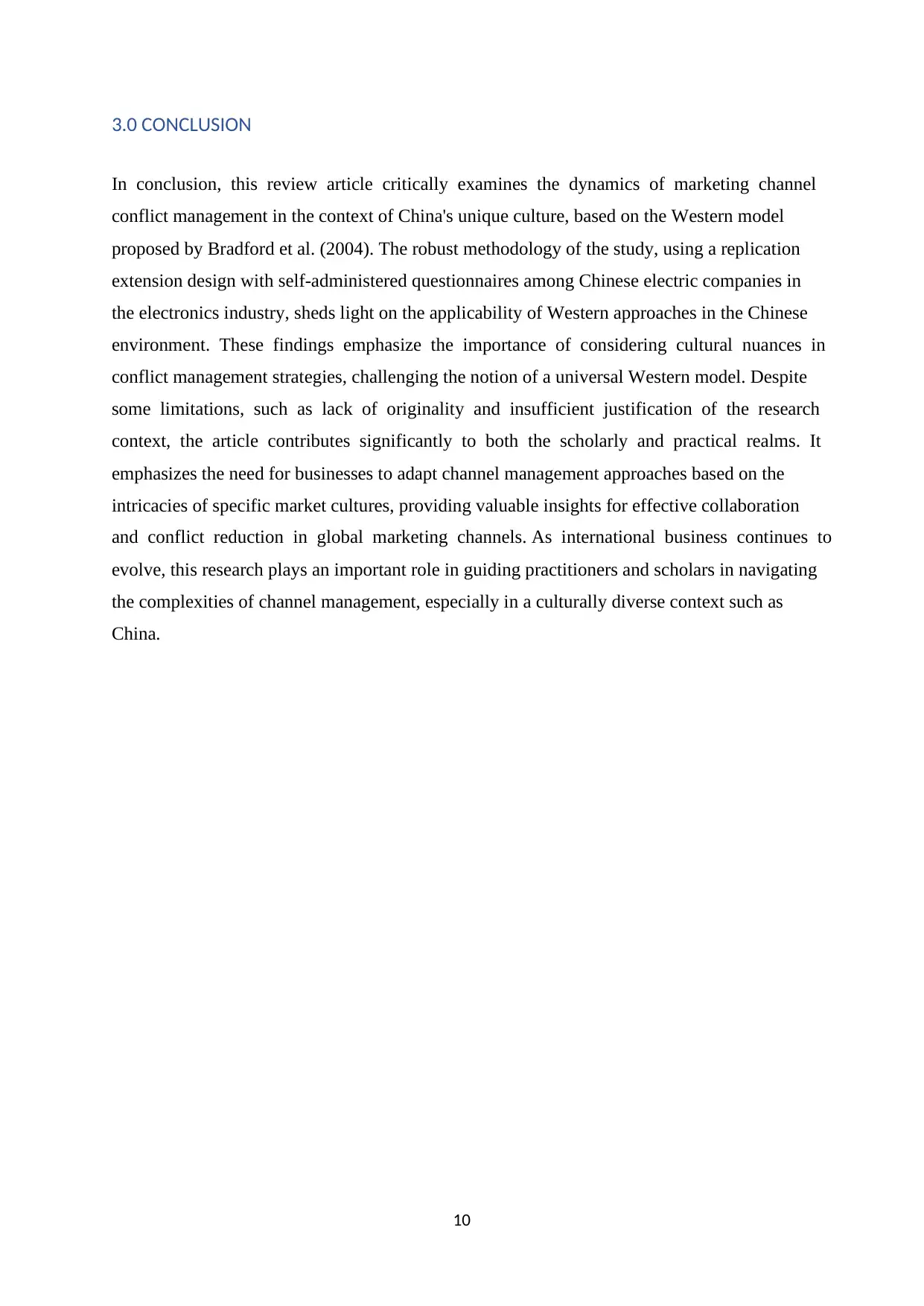
10
3.0 CONCLUSION
In conclusion, this review article critically examines the dynamics of marketing channel
conflict management in the context of China's unique culture, based on the Western model
proposed by Bradford et al. (2004). The robust methodology of the study, using a replication
extension design with self-administered questionnaires among Chinese electric companies in
the electronics industry, sheds light on the applicability of Western approaches in the Chinese
environment. These findings emphasize the importance of considering cultural nuances in
conflict management strategies, challenging the notion of a universal Western model. Despite
some limitations, such as lack of originality and insufficient justification of the research
context, the article contributes significantly to both the scholarly and practical realms. It
emphasizes the need for businesses to adapt channel management approaches based on the
intricacies of specific market cultures, providing valuable insights for effective collaboration
and conflict reduction in global marketing channels. As international business continues to
evolve, this research plays an important role in guiding practitioners and scholars in navigating
the complexities of channel management, especially in a culturally diverse context such as
China.
3.0 CONCLUSION
In conclusion, this review article critically examines the dynamics of marketing channel
conflict management in the context of China's unique culture, based on the Western model
proposed by Bradford et al. (2004). The robust methodology of the study, using a replication
extension design with self-administered questionnaires among Chinese electric companies in
the electronics industry, sheds light on the applicability of Western approaches in the Chinese
environment. These findings emphasize the importance of considering cultural nuances in
conflict management strategies, challenging the notion of a universal Western model. Despite
some limitations, such as lack of originality and insufficient justification of the research
context, the article contributes significantly to both the scholarly and practical realms. It
emphasizes the need for businesses to adapt channel management approaches based on the
intricacies of specific market cultures, providing valuable insights for effective collaboration
and conflict reduction in global marketing channels. As international business continues to
evolve, this research plays an important role in guiding practitioners and scholars in navigating
the complexities of channel management, especially in a culturally diverse context such as
China.
Paraphrase This Document
Need a fresh take? Get an instant paraphrase of this document with our AI Paraphraser
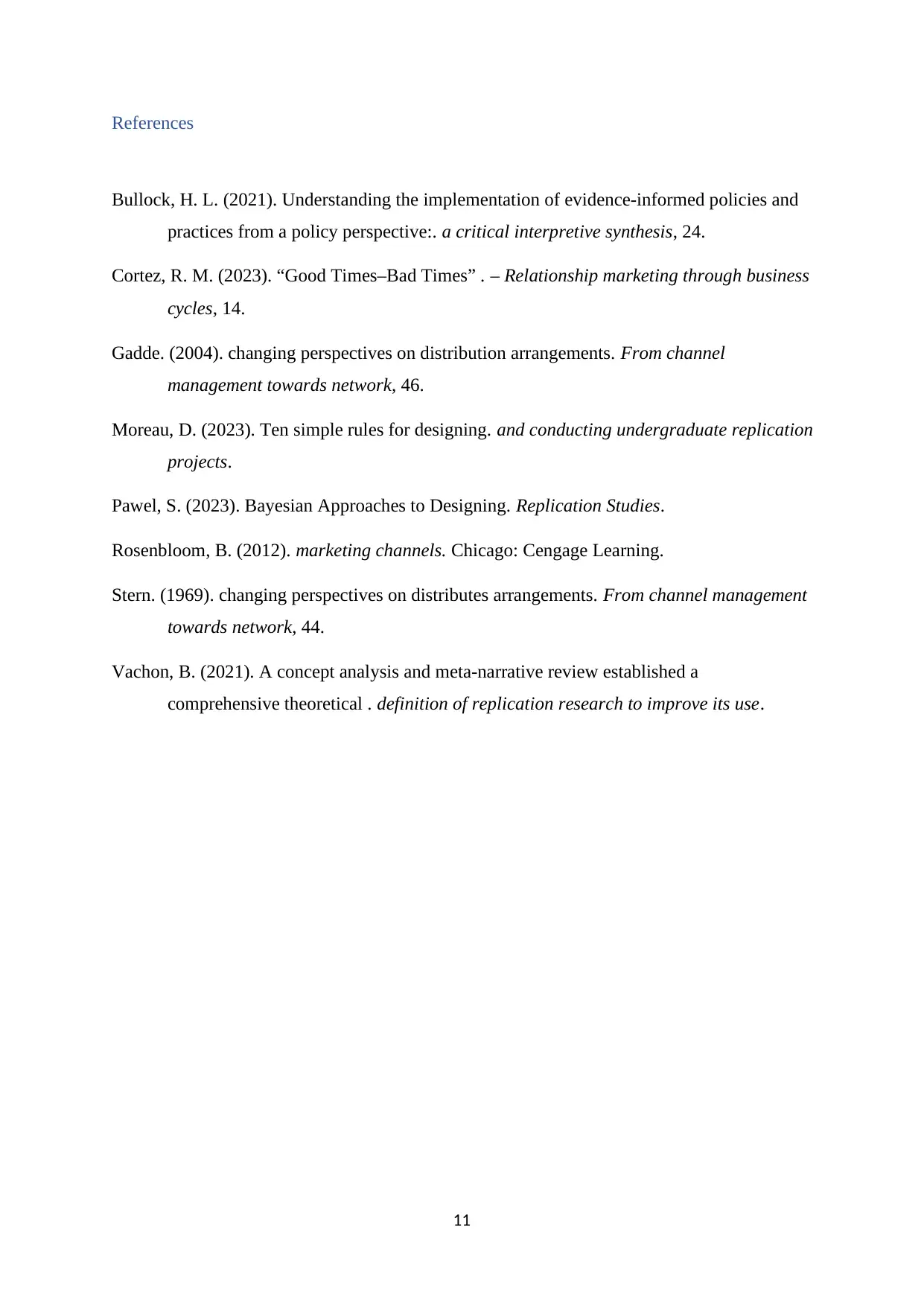
11
References
Bullock, H. L. (2021). Understanding the implementation of evidence-informed policies and
practices from a policy perspective:. a critical interpretive synthesis, 24.
Cortez, R. M. (2023). “Good Times–Bad Times” . – Relationship marketing through business
cycles, 14.
Gadde. (2004). changing perspectives on distribution arrangements. From channel
management towards network, 46.
Moreau, D. (2023). Ten simple rules for designing. and conducting undergraduate replication
projects.
Pawel, S. (2023). Bayesian Approaches to Designing. Replication Studies.
Rosenbloom, B. (2012). marketing channels. Chicago: Cengage Learning.
Stern. (1969). changing perspectives on distributes arrangements. From channel management
towards network, 44.
Vachon, B. (2021). A concept analysis and meta-narrative review established a
comprehensive theoretical . definition of replication research to improve its use.
References
Bullock, H. L. (2021). Understanding the implementation of evidence-informed policies and
practices from a policy perspective:. a critical interpretive synthesis, 24.
Cortez, R. M. (2023). “Good Times–Bad Times” . – Relationship marketing through business
cycles, 14.
Gadde. (2004). changing perspectives on distribution arrangements. From channel
management towards network, 46.
Moreau, D. (2023). Ten simple rules for designing. and conducting undergraduate replication
projects.
Pawel, S. (2023). Bayesian Approaches to Designing. Replication Studies.
Rosenbloom, B. (2012). marketing channels. Chicago: Cengage Learning.
Stern. (1969). changing perspectives on distributes arrangements. From channel management
towards network, 44.
Vachon, B. (2021). A concept analysis and meta-narrative review established a
comprehensive theoretical . definition of replication research to improve its use.
1 out of 11
Your All-in-One AI-Powered Toolkit for Academic Success.
+13062052269
info@desklib.com
Available 24*7 on WhatsApp / Email
![[object Object]](/_next/static/media/star-bottom.7253800d.svg)
Unlock your academic potential
Copyright © 2020–2025 A2Z Services. All Rights Reserved. Developed and managed by ZUCOL.